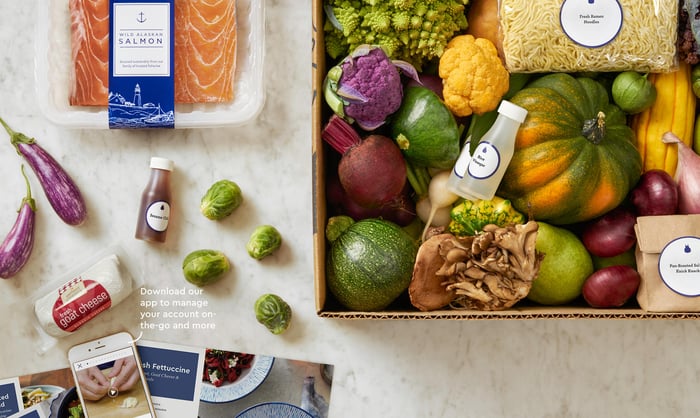Meal-kit maker Blue Apron's (APRN) public debut in late June was one of the most disappointing IPOs in recent history. The company went public at $10 per share, but it's already shed about a quarter of its value.
Unfortunately for Blue Apron, things could get much worse. Let's examine five red flags that indicate the company's high-growth days are over.

Image source: Blue Apron.
1. The repriced IPO
If investors believe that a company's best days are ahead when it goes public, the IPO usually gets oversubscribed and the asking price rises. If investors believe that its growth has peaked, demand slumps and the IPO gets repriced downwards -- which is what happened to Blue Apron.
Blue Apron was originally priced at $15 to $17 per share. However, an embarrassing lack of buyers forced the company to lower its initial price to $10 -- but even then, it seemed too pricey for open market buyers.
2. Slowing revenue growth
Blue Apron's revenue surged 338% in 2015, and another 133% to $795 million in 2016. It's illogical to expect Blue Apron to keep posting triple-digit growth, but its revenue rose just 42% during the first quarter -- indicating that its growth is peaking.
The first quarter is also usually the strongest for Blue Apron, since many of its customers go on vacation during the summer and winter -- so investors should expect even slower growth over the next three quarters.
3. Dismal customer retention rates
To make matters worse, Blue Apron's average orders per customer fell year-over-year from 4.5 to 4.1 during the quarter, while average revenue per customer dropped from $265 to $236.
This means that Blue Apron is struggling to retain its customers. A recent study by Emory University Assistant Professor Daniel McCarthy also revealed that 70% of Blue Apron's customers quit the service after just five months.

Image source: Blue Apron.
4. Contracting margins and rising expenses
Blue Apron posted a net loss of $30.8 million in 2014, which widened to $47 million in 2015 and $54.9 million in 2016. It reported a rare profit during last year's first quarter with net income of $3 million, but that figure plummeted to a loss of $52.2 million last quarter.
The problem is that its operating expenses rose 257% in 2015 and another 119% in 2016, eclipsing its total revenue during both years. Those expenses are expected to continue rising, as the company expands its workforce (which grew nearly five-fold since 2014) and beefs up its marketing efforts. Blue Apron's employees aren't unionized, but they could join a union in the future -- which could apply additional pressure on its bottom line.
5. Being put on Amazon's hit list
In the past, Blue Apron mostly dealt with smaller rivals like HelloFresh and PeachDish. But now it faces a much tougher competitor -- Amazon (AMZN -1.64%), which recently agreed to acquire Whole Foods Market (WFM).
Amazon was already aggressively promoting same-day grocery delivery services, and it partnered with Martha Stewart and Marley Spoon to launch meal kits in select markets earlier this year. The takeover of Whole Foods would give Amazon a network of hundreds of stores from which it could also deliver meal kits -- thus rendering Blue Apron and its industry peers obsolete.
Since Blue Apron is already struggling with slowing sales growth and rising operating costs, it's hard to see how it can effectively counter Amazon.
Is all hope lost?
Blue Apron faces some daunting challenges, but there are still a few reasons to be bullish. The stock isn't expensive at 1.7 times sales, compared to the industry average of 2.5 for specialty retailers. Its current market cap of $1.3 billion also remains below its private valuation of $2 billion -- which raises the possibility of a buyout.
If Blue Apron improves its customer retention rates, it might leverage its first mover's advantage to widen its moat against Amazon. Nonetheless, I'd still avoid Blue Apron unless it can prove that it's not a one-trick pony destined to be crushed by Amazon's expanding ecosystem.





